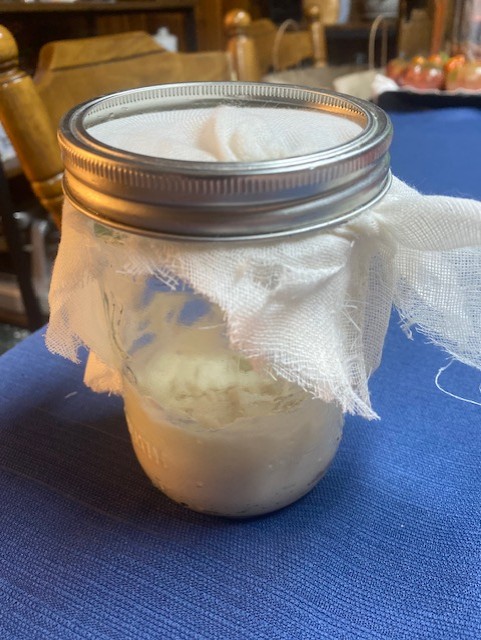
 3
3




Kenza Temsamani wrote:Hi. I used all purpose flour. Should I have been using whole wheat? I’m not quite sure what is supposed to be happening now. It’s been seven days. I’m still feeding once a day. Should it rise and fall during that time?

 7
7




 ) had to come out today and play a little.
) had to come out today and play a little.

"We're all just walking each other home." -Ram Dass
"Be a lamp, or a lifeboat, or a ladder."-Rumi
"It's all one song!" -Neil Young
 2
2




"We're all just walking each other home." -Ram Dass
"Be a lamp, or a lifeboat, or a ladder."-Rumi
"It's all one song!" -Neil Young
 5
5




 5
5




 5
5




 5
5





"We're all just walking each other home." -Ram Dass
"Be a lamp, or a lifeboat, or a ladder."-Rumi
"It's all one song!" -Neil Young
 5
5




 4
4





"We're all just walking each other home." -Ram Dass
"Be a lamp, or a lifeboat, or a ladder."-Rumi
"It's all one song!" -Neil Young
 3
3




 5
5




Saana Jalimauchi wrote:Judith, how did your 4 hour test go?
About the sweet smell. It comes from the enzymes breaking down starches to simple sugars. Yes, it's a good thing. A starter can go too sweet though, but I don't think that's a problem you're having at the moment, especially if your grandson is saying good things about the smell.
Every starter smells a bit different. The thing that effects most is the flour used. Mine doesn't smell that sweet.

"We're all just walking each other home." -Ram Dass
"Be a lamp, or a lifeboat, or a ladder."-Rumi
"It's all one song!" -Neil Young
 8
8




Weeds are just plants with enough surplus will to live to withstand normal levels of gardening!--Alexandra Petri
 4
4





 4
4




"We're all just walking each other home." -Ram Dass
"Be a lamp, or a lifeboat, or a ladder."-Rumi
"It's all one song!" -Neil Young
 4
4




Judith Browning wrote:A question when you have some time...nothing urgent.
When I remove the starter from the refrigerator to use, I first feed it and then do I stir it back down and take from that for the bread or do I take from the risen part of the starter?
whether to stir it up and then remove some as I've been doing or remove only from the top?
 4
4




So you have been taking excess starter out from the jar and feeding water and flour to what's left, right?
I don't really think it matters if you mix it or just remove from the top. If there's hooch on top I think mixing it in would be wise.
Although your hooch line has been in the middle mostly? Out of curiosity, when you feed the starter, do you first mix the starter with water in to a milky consistensy or do you add water and flour at the same time and mix them both in?
"We're all just walking each other home." -Ram Dass
"Be a lamp, or a lifeboat, or a ladder."-Rumi
"It's all one song!" -Neil Young
 4
4




Judith Browning wrote:
Thank you!
Before feeding, I've been stirring the risen starter with my chopstick and then removing the amount to feed from that jar to a new jar each time...
Now that it's stored in the refrigerator how should I cover the jar? A loose lid?
I'm really excited to have a good starter...thank you so much for walking us through the process and answering questions!

 7
7





"We're all just walking each other home." -Ram Dass
"Be a lamp, or a lifeboat, or a ladder."-Rumi
"It's all one song!" -Neil Young
 9
9




 10
10




Almond Thompson wrote:Hey guys, I'm doing the tooth diet and they say sourdough is ok to eat because the grain has been fermented to remove the phytic acid. However most recipes I've found involve adding fresh flour to the starter before baking. Doesn't that defeat the purpose?

Gardens in my mind never need water
Castles in the air never have a wet basement
Well made buildings are fractal -- equally intelligent design at every level of detail.
Bright sparks remind others that they too can dance
What I am looking for is looking for me too!

 11
11




The wheat we're growing is much different - just like we've chosen characteristics in fruit and veg that are designed for Industrial farming and shipping (think Iceberg lettuce), the same is true of wheat. The way we grow and harvest it is much different. The way we grind it - high speed mechanical that's likely to heat the wheat changing it's nutrition. And lastly, the way we bake it.Pearl Sutton wrote:One of the interesting things about bread is the whole "white flour, fine density, high loaf" bit is not historical at all. Most bread people ate was made closer to how I do it, and the wheat was different type (including higher protein) and it was gathered into shocks and fermentation started on it in the fields. Modern wheat types and fast harvest techniques lead to a lot of people not being able to digest it, and blaming gluten for the problem, when what we call bread is not what our ancestors ate.
Visit Redhawk's soil series: https://permies.com/wiki/redhawk-soil
How permies.com works: https://permies.com/wiki/34193/permies-works-links-threads
 7
7




Judith Browning wrote:Just checking in wondering how other's starters are doing?
I'm really happy with mine!
Have been practicing making crackers from recipes found elsewhere here and just got a 25# bag of hard red wheat berries and one of rye so have been grinding a bit of flour and have a winter to play.
Just for fun I divided my starter this morning and fed one jar with rye flour and one with soft wheat as usual...will switch from soft to hard wheat soon.
Sourdough crackers are bagged for todays hike.
Thank you again Saana...I tease my baker son that I had to learn to make a good starter from someone from Finland.
 I'm glad you're happy with your starter!
I'm glad you're happy with your starter! 
Almond Thompson wrote:Hey guys, I'm doing the tooth diet and they say sourdough is ok to eat because the grain has been fermented to remove the phytic acid. However most recipes I've found involve adding fresh flour to the starter before baking. Doesn't that defeat the purpose?
 3
3




![Filename: c5377804b2d610dab80be735a48c6d6d-1212895280-2.jpg
Description: [Thumbnail for c5377804b2d610dab80be735a48c6d6d-1212895280-2.jpg]](/t/231560/a/227691/c5377804b2d610dab80be735a48c6d6d-1212895280-2.jpg)
"We're all just walking each other home." -Ram Dass
"Be a lamp, or a lifeboat, or a ladder."-Rumi
"It's all one song!" -Neil Young
 6
6





 4
4




PURPLE CARDS! GET YOUR GARDENING CARDS HERE!! https://www.kickstarter.com/projects/paulwheaton/garden-cards?ref=4qylf3. "The only thing...more expensive than education is ignorance."~Ben Franklin. "We can easily forgive a child who is afraid of the dark; the real tragedy of life is when men are afraid of the light." ~ Plato
 11
11




 3
3




Saana Jalimauchi wrote:How are your starters, everyone? Baked anything?

In the SKIP program the is a BB for making two loaves of bread! and if you are in to fermenting other stuff too, you can incorporate your sourdough starter into the Ferment Four Different Things (One Gallon). It does require some time adding up to a gallon of used starter but it's possible!
"We're all just walking each other home." -Ram Dass
"Be a lamp, or a lifeboat, or a ladder."-Rumi
"It's all one song!" -Neil Young
 4
4




Wow, that is a lovely scraper! Please tell Steve I admire it. A simple, but practical tool.Judith Browning wrote:And Steve made me this wonderful scraper!
Visit Redhawk's soil series: https://permies.com/wiki/redhawk-soil
How permies.com works: https://permies.com/wiki/34193/permies-works-links-threads
 7
7




 6
6






 6
6




 6
6





 12
12





- Tim's Homestead Journal - Purchase a copy of Building a Better World in Your Backyard - Purchase 6 Decks of Permaculture Cards -
- Purchase 12x Decks of Permaculture Cards - Purchase a copy of the SKIP Book - Purchase 12x copies of Building a Better World in your Backyard
 5
5




 6
6




--
"Whitewashed Hope: A Message from 10+ Indigenous Leaders and Organizations"
https://www.culturalsurvival.org/news/whitewashed-hope-message-10-indigenous-leaders-and-organizations

 2
2




How Permies works: https://permies.com/wiki/34193/permies-works-links-threads
My projects on Skye: The tree field, Growing and landracing, perennial polycultures, "Don't dream it - be it! "

|
Now I am super curious what sports would be like if we allowed drugs and tiny ads.
The new kickstarter is now live!
https://www.kickstarter.com/projects/paulwheaton/garden-cards
|








